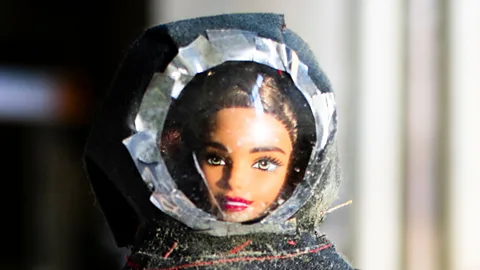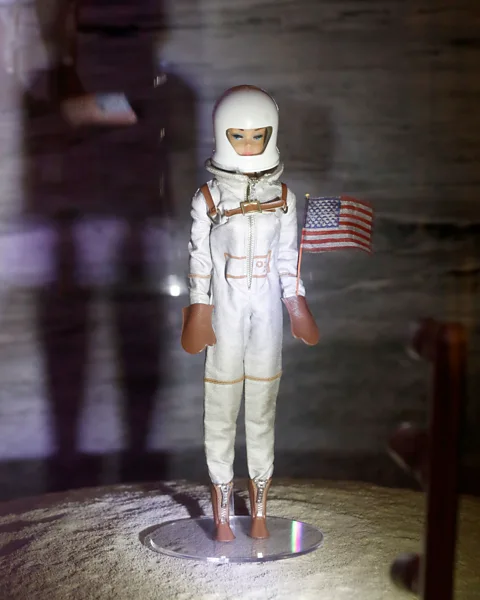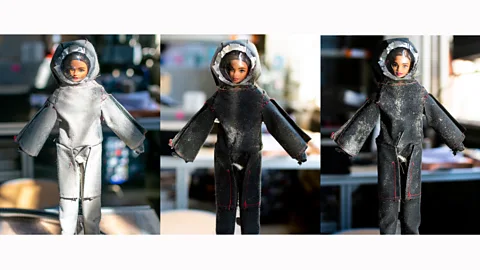Barbie's surprising role in Moon exploration
 Ian Wells/WSU HYPER Lab
Ian Wells/WSU HYPER LabBarbie dolls dressed in space suits have been helping scientists solve the problem of lunar dust, writes Grace Tyrrell.
Barbie can do it all. In Greta Gerwig’s 2023 film, she appears as a US president, a Nobel Prize winning physicist, a Supreme Court Justice and even a mermaid. The movie reflects the many roles the doll has had over the decades.
Unexpected Elements
This story is adapted from an episode of Unexpected Elements on BBC World Service. It was presented by Marnie Chesterton, produced by Ben Motley, with Margaret Sessa-Hawkins, Alex Mansfield and Sophie Ormiston. Listen to more episodes of Unexpected Elements.
One of her most famous is as a space explorer. In the 1960s, Astronaut Barbie was transporting children on space adventures even before Nasa's own astronauts had taken their first steps on the Moon and 13 years before Nasa began accepting female astronauts into their programme.
Now Barbie has been helping space exploration for real. In recent experiments, scientists used the dolls to test methods of removing Moon dust from spacesuits. Wearing a tailor-made spacesuit, Barbie was coated in volcanic ash by a team from Washington State University and sprayed with liquid nitrogen. They found this technique is more effective than previous cleaning methods.
Why is lunar dust a problem? Moon dust is "ubiquitous, abrasive and electrically charged", according to Ian Wells, a graduate researcher at Washington State University, who was speaking to the BBC World Service programme Unexpected Elements. These "annoyingly clingy" microscopic particles statically stick to the spacesuits of astronauts and are difficult to clean off.
During the Apollo missions, astronauts were unable to remove the dust using standard brushes, resulting in damage to the seals on their spacesuits.
"If there's enough dust on the seals, or enough abrasion occurs, then those seals won't sit properly… you'll either have a leak or it won't seal at all," Wells later told BBC Future.
 Getty Images
Getty ImagesBeyond damage to the suits, lunar dust can cause serious damage to the lungs if inhaled, with Wells comparing it to "breathing ground-up fibreglass". With future plans to travel to the Moon again already in progress, the need for a novel cleaning technique to prevent damage to spacesuits and astronauts is clear.
You might also like:
Wells and the team from Washington State University were inspired to tackle this problem following research into the "Leidenfrost effect". This physical phenomenon is akin to dropping water onto a hot saucepan, causing the water droplets to bounce around the surface, propelled and encapsulated by their own evaporating vapour.
After pouring some left-over liquid nitrogen onto the floor, Wells realised that any dust was being picked up and moved towards the lowest point of the surface. "We knew it was the Leidenfrost effect, but we didn’t know why it was picking up the dust," he told BBC Future.
Wells and colleagues figured that spraying space suits with liquid nitrogen could produce a similar effect. On the Unexpected Elements programme, he described it as a sort of "cryogenic carwash", where liquid nitrogen could be sprayed onto the astronaut as they enter the habitat from the lunar surface.
The team tested their liquid nitrogen spray on fabric in both ambient and Moon-like vacuum environments. However, when sourcing lunar dust, they had to get creative.
"Real Moon dust is actually illegal to own," Wells said. "Our stimulant was actually ash from the eruption of Mount St Helens and we found that it had very similar properties for what we were testing."
The liquid nitrogen spray works by using a combination of the Leidenfrost effect but also the "boiling liquid expanding vapour explosion" (Bleve) effect. The latter causes the liquid nitrogen to convert to gas, propelling some Moon dust into the surrounding air.
Finding a way to remove the propelled dust from the air before astronauts take off their spacesuits remains an unanswered question, "otherwise they're going to risk getting it back into their lungs", explained Wells.
The study, published in Acta Astronautica, reported a 97% and 98.4% removal by mass when tested in the ambient environment and vacuum environment respectively.
Following the initial success of the experiments, Wells and colleagues decided to test scale models to ensure the liquid nitrogen spray was working. It was time for Barbie to don a spacesuit again.
"We dressed this Barbie up in her suit, covered her in dust and then used a spray bar and we were able to actually turn Barbie 360 [degrees] as an astronaut would in an airlock," Wells told Unexpected Elemtents. "We had very high removal and also importantly… minimal damage to the spacesuit.”
 Ian Wells, WSU HYPER Lab
Ian Wells, WSU HYPER LabAccording to Wells, the team from Washington State University named their Barbie "Rosie", after the American figure Rosie the Riveter who represented the women who took up factory jobs during World War Two.
"Personally, I wanted to name her Barb, after Barbie, but also after one of my personal idols Barbara Morgan, who is an astronaut from my home State of Idaho," Wells told BBC Future. Astronauts like Morgan are likely to be a major inspiration for the continued development of Barbies, with two of the most recent "Space Discovery Barbies" even venturing to the International Space Station in 2022.
The next stages of research hope to better mimic the environment seen on the Moon, including simulating the static charge of the lunar dust itself. Wells is hopeful that this method will be tested on the Moon, but using a human astronaut rather than a life-sized Barbie model.
"We actually have the Barbie, and we bring her around to conferences… I don't think she'll be doing any more tests. I think she's she served her time. But we'll definitely be looking at real life astronauts," said Wells.
Whilst Barbie Rosie may have been retired from future experiments, her role in this piece of research shows how even a plastic toy can play a part in future celestial exploration.
--
